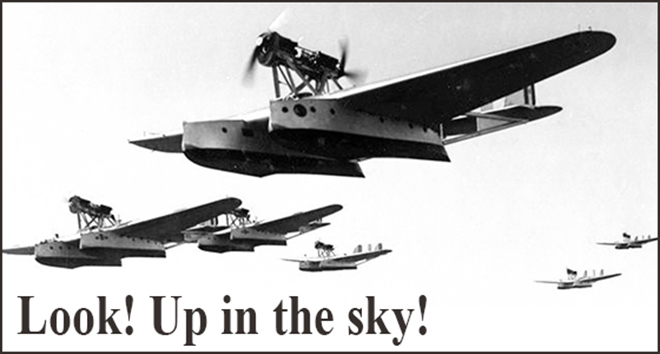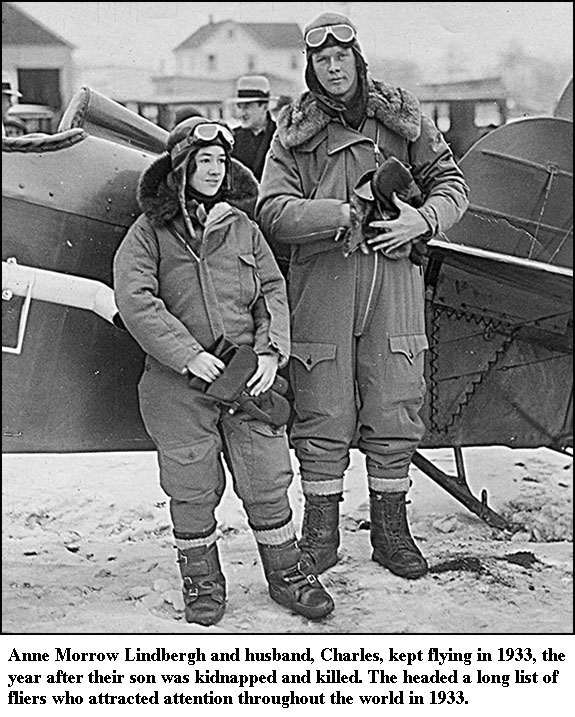| HOME • FAMILY • YESTERDAY • SOLVAY • STARSTRUCK • MIXED BAG |
 |
 |
| Nearly every day in 1933 brought news about aviation and daring pilots who were out to set new records, to fly where no one had ever flown before, and to do it faster. One of the year's biggest aviation events began and ended in Italy. It involved a fleet of unusual-looking planes (above) under the command of Italo Balbo, a colorful fellow who became so popular in his homeland that he incurred the jealousy of dictator Benito Mussolini, who would, in effect, banish Baldo from the country. |
| The Fantastic Flying Lindberghs Charles Lindbergh became famous flying solo across the Atlantic Ocean in 1927, but what he and his wife accomplished in the air in 1933 was equally impressive. And, no, Anne Morrow Lindbergh wasn't just along for the ride. |
 |
| ——————————————————————————————————— |
| Balbo's really big show He was called the ringmaster of Italy's Flying Circus. General Italo Balbo, Italy's Minister of Air, led a squadron of seaplanes across the Atlantic Ocean, headed for Chicago and the city's world fair. |
| ——————————————————————————————————— |
| Too much weight, not enough power Another Italian flier, General Francesco De Pinedo, made headlines, but for tragic reasons. De Pinedo had been his country's most famous aviator before Italo Baldo came alone, and in his eagerness to recapture former glory, made a fatal mistake. |
| ——————————————————————————————————— |
| Anderson was largely ignored C. Alfred Anderson was one of the early black American pilots, and, as such, he didn't generate much attention except in the Negro press. However, among his passengers was our first lady, Eleanor Roosevelt. |
| ——————————————————————————————————— |
| Famous pilot, famous passenger Amelia Earhart, who flew to fame in 1932, had a relatively quiet year in 1933, but she occasionally was in the news, like the time she and the nation's First Lady impulsively decided it was a nice night to go flying. |
| ——————————————————————————————————— |
| Secret flight ends in two deaths Keeping their plans to themselves, two Chicago residents didn't bother to get authorization before they attempted to fly nonstop to their homeland, Lithuania. Stephen Darius and Stanley T. Girenas managed to cross the Atlantic, but, tragically, crashed short of their destination. |
| ——————————————————————————————————— |
Around the world by himself |
| ——————————————————————————————————— |
| Lost in Siberia Pilot Jimmy Mattern was the focal point of an international human interest story when his plane disappeared over Siberia, and almost a month passed before it was learned he was alive and well in a Siberian town called Anadyr. |
| ——————————————————————————————————— |
| Mollison wasted little time Also in the news in 1933 were James Allan ("Jim") Mollison and Amy Johnson, each a famous aviator before they met the year before when they teamed up for a flight. He proposed eight hours later — while they were still in the air. |
| ——————————————————————————————————— |
They flew and they flew and they flew |
| ——————————————————————————————————— |
Hawks proved autopilot could work |
| ——————————————————————————————————— |
Nice ship, Doc, but what's with the swastika? |
| ——————————————————————————————————— |
| Bad times for United States airships However, there was no glory, only disaster for the United States dirigible USS Akron, when it became the latest of several airships to meet disaster, killing 73 when it crashed into the Atlantic off New Jersey. One of three survivors was Lieutenant Commander Herbert V. Wiley, who a year later would survive another dirigible crash aboard the USS Macon. |
| ——————————————————————————————————— |
| Well, he came close Capt. J. Erroll Boyd, known as the Lindbergh of Canada, flew 2,471 miles nonstop from New York to Haiti. Bad weather forced him down, but he avoided disaster by making a perfect landing in St. Marc, Haiti, about 45 miles short of his target, Port au Prince. |
| ——————————————————————————————————— |
Their joy was short-lived |
| HOME • CONTACT |